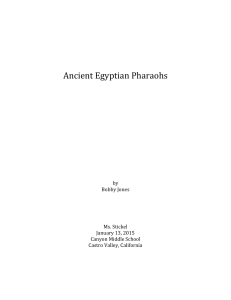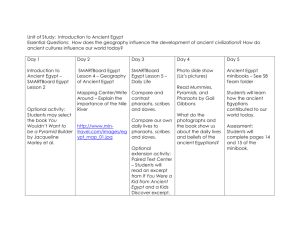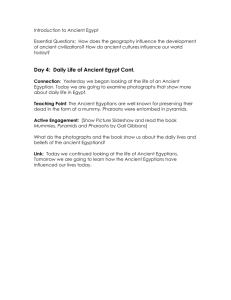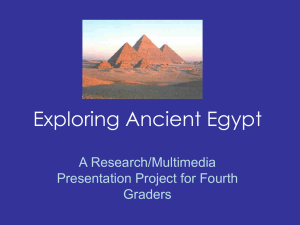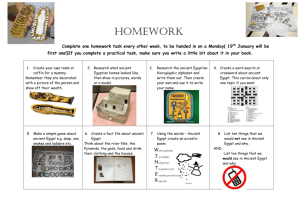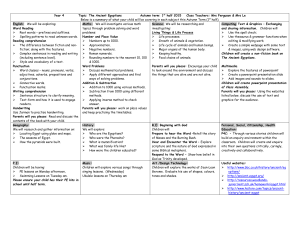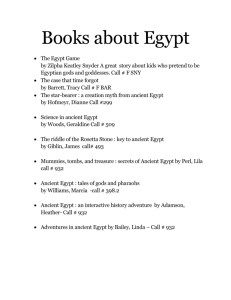Ancient Mediterranean and Mesopotamia Value 1.0
advertisement
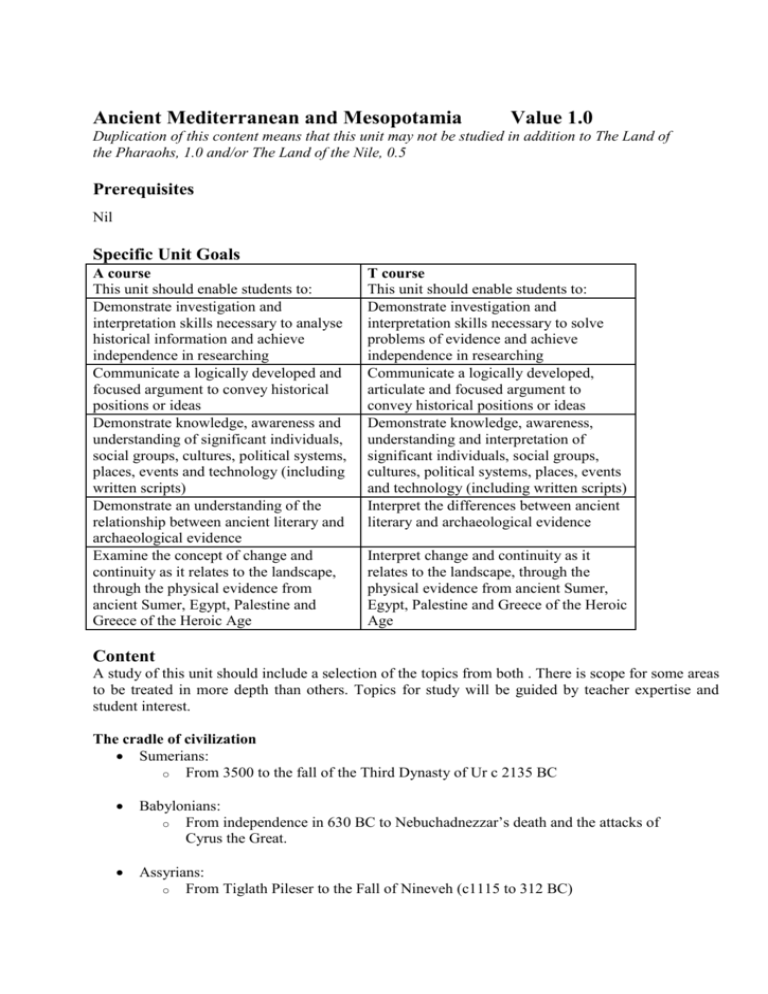
Ancient Mediterranean and Mesopotamia Value 1.0 Duplication of this content means that this unit may not be studied in addition to The Land of the Pharaohs, 1.0 and/or The Land of the Nile, 0.5 Prerequisites Nil Specific Unit Goals A course This unit should enable students to: Demonstrate investigation and interpretation skills necessary to analyse historical information and achieve independence in researching Communicate a logically developed and focused argument to convey historical positions or ideas Demonstrate knowledge, awareness and understanding of significant individuals, social groups, cultures, political systems, places, events and technology (including written scripts) Demonstrate an understanding of the relationship between ancient literary and archaeological evidence Examine the concept of change and continuity as it relates to the landscape, through the physical evidence from ancient Sumer, Egypt, Palestine and Greece of the Heroic Age T course This unit should enable students to: Demonstrate investigation and interpretation skills necessary to solve problems of evidence and achieve independence in researching Communicate a logically developed, articulate and focused argument to convey historical positions or ideas Demonstrate knowledge, awareness, understanding and interpretation of significant individuals, social groups, cultures, political systems, places, events and technology (including written scripts) Interpret the differences between ancient literary and archaeological evidence Interpret change and continuity as it relates to the landscape, through the physical evidence from ancient Sumer, Egypt, Palestine and Greece of the Heroic Age Content A study of this unit should include a selection of the topics from both . There is scope for some areas to be treated in more depth than others. Topics for study will be guided by teacher expertise and student interest. The cradle of civilization Sumerians: o From 3500 to the fall of the Third Dynasty of Ur c 2135 BC Babylonians: o From independence in 630 BC to Nebuchadnezzar’s death and the attacks of Cyrus the Great. Assyrians: o From Tiglath Pileser to the Fall of Nineveh (c1115 to 312 BC) Syria, Palestine & Anatolia: o City states of the Early and Middle Bronze Age. o The Hittite Empire. o New States of the Iron Age: Phoenecians, Arameans, Philistines, Hebrews (The Kingdom of Israel), Syro-Hittite kingdoms, Phrygian kingdoms, Uratu. Particular attention will be given to: o Religion and Mythology. The Epic of Gilgamesh. o Development of Writing and modern decipherment. o Economic and diplomatic relations with Egypt, Iran, Anatolia, Syria, Palestine and India. o Excavations at Ur, Nineveh, Nimrud, Balawat, Khorsabad, Asshur, Babylon, Uruk and Lagash. o Development of archaeological techniques. Ancient Egypt Introduction to Ancient Egypt: o Prehistory, political geography, religion, mythology and the power of the pharaoh. The Old Kingdom: o Emphasis on the 3rd and 4th Dynasties. o The development of the pyramid o Religious beliefs and funerary practices God Kings and the Administration Of Power o The Middle Kingdom and the Hyksos The New Kingdom: o Emphasis on the 17th and 18th Dynasties o Specific pharaohs – Akhenaten, Ramses the Great and Hatshepshut. o The Valley of the Kings and New Kingdom funerary practices. o The Great Temple complexes. o Deir el Medina: a case study. Crete and Troy o The Minoans o Society and Civlisation. o Literature – “Theseus and the Minotaur” and Plato’s “Atlantis”. o Thera. o The Myceneaens. o Society and Civlisation. o The Trojans. o Homer’s Iliad. o Archaeological evidence for the war evaluation of the historicity of Homer’s legend Teaching and Learning Strategies Relevant and effective strategies will focus on investigating and interpreting evidence in: Primary sources – e.g. diaries, posters, graffiti, letters, photographs, artefacts Secondary sources –e.g. biographies, texts, documentaries, film and historical novel Statistical data – e.g. maps, charts, graphs. Kinesthetic activities, e.g. role plays and imaginative reconstructions of key events, model making and visits to institutions, films, artistic interpretations or historic sites may also be used to investigate and interpret evidence Visits to relevant museums, galleries, etc. Guest speakers when available and appropriate. Findings will be communicated through: Writing – e.g. essay writing, document studies, empathetic exercises Oral and aural activities – e.g. class discussions, debates, guest speakers, oral histories, group work, quizzes ICT – e.g. web quests, spreadsheet analyses, computer games, PowerPoint presentations, Internet searches. See Teaching and Learning Strategies in the main document and the History Course Framework for other teaching strategies. Assessment Task Types See pages 335-337 for assessment information Student Capabilities Creative and critical thinkers Enterprising problem-solvers Skilled and empathetic communicators Informed and ethical decision-makers Environmentally and culturally aware citizens Confident and capable users of technologies Independent and self-managing learners Collaborative team members Evidence could be found in: Goals Content Teaching Assessment and Learning √ √ √ √ √ √ √ √ √ √ √ √ √ √ √ √ √ √ √ √ Specific Unit Resources Aldred, C Avi Yonah, Michael, Barnett, RD Bierbrier, ML Calendar, Gae Cremin, Aedien, The Egyptians, 2nd ed, London, 1984. Introducing Archaeology, Cassell and Company, London, 1973. Assyrian Palace Reliefs, British Museum Publications, London, 1976. Illustrations of Old Testament History, British Museum Publications, London, 2nd edn, 1977. The Tomb Builders of the Pharaohs, London, 1982. Egypt in the Old Kingdom, Longman, South Melbourne, 1998 The Enduring Past: Archaeology of the Ancient World for Australians, New South Wales, University Press, Kensington, 1988. Crawford, Harriet Sumer and the Sumerians, C.U.P. Cambridge, 1991. Frankfort, Henri The Art and Architecture of the Ancient Orient, Penguin, Harmondsworth, 1970, 1979 reprint. Hallo, William W & James, An Introduction to Ancient Egypt, London, 1979. TGH Homer The Illiad, Penguin Homer Pharaoh’s People, London, 1984 Koutsoukis, A.J. Ancient Egypt, Mesopotamia and Persia, Longman Cheshire, Melbourne, 1990. Lloyd, Seton, The Archaeology of Mesopotamia, Thames and Hudson, London, 2nd edn, 1978. Luckenbill, DD, Ancient Records of Babylonia and Assyria, Vols I and II, University of Chicago Press, Chicago, 1926, 1927. Montet, P Everyday Life in the Days of Ramesses the Great, London, 1958. Pritchard, JB The Ancient Near East. A New Anthology of Texts and Pictures Vols I, II, Princeton University Press, Princeton, 1973, 1975. Reade, J, Assyrian Sculpture, British Museum Publications, London, 1983. Simpson, William Kelly The Ancient Near East: A History, Harcourt Brace Jovanovich, San Diego 1971. Audio Visual Mesopotamian Art (The History of Western Art: 2) News from Mesopotamia 1998 Iraq: The Cradle Of Civilisation 1993 Ancient Lives The Pyramid Builders The Great Pyramid – Gateway to the Stars 1994 Ghosts of Wonder 1996 Ancient Egypt 1998 These were accurate at the time of publication. Please see the Bibliography on page 31 of part 1 of the course for further resources.

